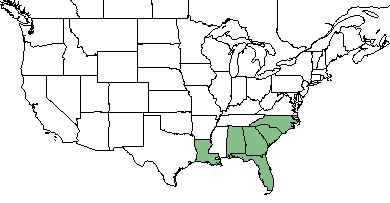Difference between revisions of "Rhynchospora odorata"
(→Distribution) |
|||
| Line 31: | Line 31: | ||
==Ecology== | ==Ecology== | ||
===Habitat=== <!--Natural communities, human disturbed habitats, topography, hydrology, soils, light, fire regime requirements for removal of competition, etc.--> | ===Habitat=== <!--Natural communities, human disturbed habitats, topography, hydrology, soils, light, fire regime requirements for removal of competition, etc.--> | ||
| + | ''R. odorata'' proliferates in maritime swamp forests and maritime wet grasslands. <ref name= "Weakley 2015"> Weakley, A. S. (2015). Flora of the Southern and Mid-Atlantic States. Chapel Hill, NC, University of North Carolina Herbarium. </ref> | ||
<!--===Phenology===--> <!--Timing off flowering, fruiting, seed dispersal, and environmental triggers. Cite PanFlora website if appropriate: http://www.gilnelson.com/PanFlora/ --> | <!--===Phenology===--> <!--Timing off flowering, fruiting, seed dispersal, and environmental triggers. Cite PanFlora website if appropriate: http://www.gilnelson.com/PanFlora/ --> | ||
<!--===Seed dispersal===--> | <!--===Seed dispersal===--> | ||
Revision as of 12:52, 29 May 2018
| Rhynchospora odorata | |
|---|---|

| |
| Photo by John Gwaltney hosted at Southeastern Flora.com | |
| Scientific classification | |
| Kingdom: | Plantae |
| Division: | Magnoliophyta - Flowering plants |
| Class: | Liliopsida - Moncots |
| Order: | Poales |
| Family: | Cyperaceae |
| Genus: | Rhynchospora |
| Species: | R. odorata |
| Binomial name | |
| Rhynchospora odorata C. Wright ex Griseb. | |

| |
| Natural range of Rhynchospora odorata from USDA NRCS Plants Database. | |
Contents
Taxonomic Notes
Synonym: R. stipitata (Chapman)
Variety: none
Description
R. odorata is a perennial graminoid of the Cyperaceae family that is native to North America. [1]
Distribution
R. odorata is commonly found in the southeastern United States; specifically Florida, Georgia, South Carolina, North Carolina, Alabama, and Louisiana. [1]
Ecology
Habitat
R. odorata proliferates in maritime swamp forests and maritime wet grasslands. [2]
Conservation and Management
Cultivation and restoration
Photo Gallery
References and notes
- ↑ 1.0 1.1 USDA Plant Database
- ↑ Weakley, A. S. (2015). Flora of the Southern and Mid-Atlantic States. Chapel Hill, NC, University of North Carolina Herbarium.